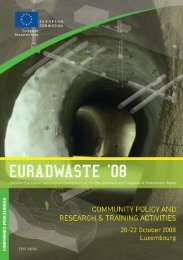EU industrial structure - EU Bookshop - Europa
EU industrial structure - EU Bookshop - Europa
EU industrial structure - EU Bookshop - Europa
Create successful ePaper yourself
Turn your PDF publications into a flip-book with our unique Google optimized e-Paper software.
Chapter III — Drivers of Sector Growth and Competitiveness<br />
FIgURE III.11: Average annual growth in labour productivity 1997-2010 (%). Production per employed<br />
15<br />
10<br />
5<br />
0<br />
-5<br />
-10<br />
-15<br />
1997 1998 1999 2000 2001 2002 2003 2004 2005 2006 2007 2008 2009 2010 2011<br />
Source: own calculations using Eurostat and OECD data.<br />
iii22 unit labour costs<br />
Unit labour costs (ULC) are defined as the ratio of labour<br />
costs per employee to value added per employee. Since<br />
developments in ULC show if nominal wages increase in line<br />
with productivity, it can be regarded as a measure of cost<br />
competitiveness. Cost competitiveness across <strong>EU</strong> sectors<br />
appears to be very variable. High <strong>EU</strong> ULC growth rates<br />
during 2009 are explained by production decreasing more<br />
than employment at given labour costs. This occurred in many<br />
manufacturing industries. Box III.3 provides more insight into<br />
the methodology and interpretation of unit labour costs.<br />
The performance of manufacturing industries, together<br />
with mining and quarrying, in terms of ULC growth rates<br />
is compared below. The comparison aims to show which<br />
industries perform particularly well relative to aggregate<br />
manufacturing. The comparison is made for different time<br />
periods since 2000 to facilitate a comparison of ULC growth<br />
rates before and during the latest crisis. The period 2000‑<br />
2005 was clearly influenced by relatively high labour<br />
productivity developments and characterised by low<br />
ULC growth. Manufacturing as a whole witnessed almost<br />
stable ULC at +0.6 %. Almost all sectors, with the particular<br />
exception of leather and footwear, tobacco, clothing<br />
and other transport equipment, were characterised by<br />
increasing ULC. during the period 2005‑10 the situation<br />
deteriorated for mining and aggregate manufacturing,<br />
and for almost all manufacturing subsectors This is the<br />
normal situation during recessions when production falls<br />
rapidly while adjustments of labour are more sluggish<br />
The same developments also explain why labour productivity<br />
growth decreases during recessions. Both ULC and labour<br />
productivity move pro‑cyclical.<br />
Computer, electronic and optical products, pharmaceuticals,<br />
and clothing did not see their ULC increase. A word of<br />
caution is necessary when interpreting the figures. The<br />
results in the table are strongly dependent on the chosen<br />
time period. The recovery during 2010 has increased<br />
productivity growth while, at the same time, wage<br />
increases have been modest. That lowers ULC growth rates<br />
substantially in industries such as basic metals and motor<br />
vehicles. Choosing 2000‑2009 yields higher ULC growth<br />
rates than 2000‑2010 since production, and consequently<br />
productivity growth, fell heavily during 2009, cf. Table III.2.<br />
67
















